Reflective Study on Networking Technologies
VerifiedAdded on 2023/01/18
|6
|1048
|74
AI Summary
This reflective study explores networking technologies such as APIPA, subnetting, routers, and switches. It discusses the allocation of IP addresses and the need for routers in inter-VLAN communication.
Contribute Materials
Your contribution can guide someone’s learning journey. Share your
documents today.

Running head: REFLECTIVE STUDY ON NETWORKING TECHNOLOGIES
Reflective study on Networking Technologies
Name of the Student
Name of the University
Author Note
Reflective study on Networking Technologies
Name of the Student
Name of the University
Author Note
Secure Best Marks with AI Grader
Need help grading? Try our AI Grader for instant feedback on your assignments.
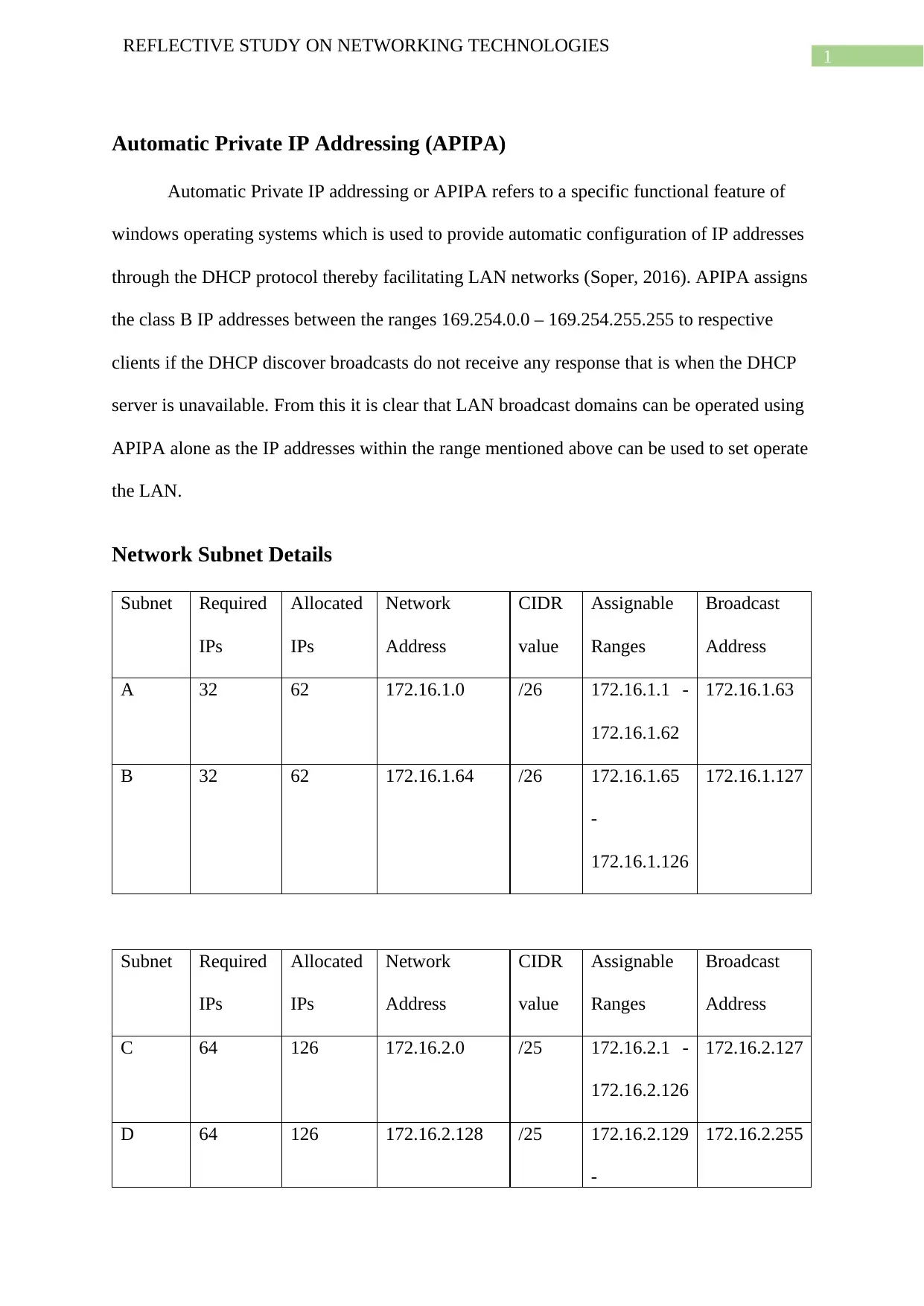
1
REFLECTIVE STUDY ON NETWORKING TECHNOLOGIES
Automatic Private IP Addressing (APIPA)
Automatic Private IP addressing or APIPA refers to a specific functional feature of
windows operating systems which is used to provide automatic configuration of IP addresses
through the DHCP protocol thereby facilitating LAN networks (Soper, 2016). APIPA assigns
the class B IP addresses between the ranges 169.254.0.0 – 169.254.255.255 to respective
clients if the DHCP discover broadcasts do not receive any response that is when the DHCP
server is unavailable. From this it is clear that LAN broadcast domains can be operated using
APIPA alone as the IP addresses within the range mentioned above can be used to set operate
the LAN.
Network Subnet Details
Subnet Required
IPs
Allocated
IPs
Network
Address
CIDR
value
Assignable
Ranges
Broadcast
Address
A 32 62 172.16.1.0 /26 172.16.1.1 -
172.16.1.62
172.16.1.63
B 32 62 172.16.1.64 /26 172.16.1.65
-
172.16.1.126
172.16.1.127
Subnet Required
IPs
Allocated
IPs
Network
Address
CIDR
value
Assignable
Ranges
Broadcast
Address
C 64 126 172.16.2.0 /25 172.16.2.1 -
172.16.2.126
172.16.2.127
D 64 126 172.16.2.128 /25 172.16.2.129
-
172.16.2.255
REFLECTIVE STUDY ON NETWORKING TECHNOLOGIES
Automatic Private IP Addressing (APIPA)
Automatic Private IP addressing or APIPA refers to a specific functional feature of
windows operating systems which is used to provide automatic configuration of IP addresses
through the DHCP protocol thereby facilitating LAN networks (Soper, 2016). APIPA assigns
the class B IP addresses between the ranges 169.254.0.0 – 169.254.255.255 to respective
clients if the DHCP discover broadcasts do not receive any response that is when the DHCP
server is unavailable. From this it is clear that LAN broadcast domains can be operated using
APIPA alone as the IP addresses within the range mentioned above can be used to set operate
the LAN.
Network Subnet Details
Subnet Required
IPs
Allocated
IPs
Network
Address
CIDR
value
Assignable
Ranges
Broadcast
Address
A 32 62 172.16.1.0 /26 172.16.1.1 -
172.16.1.62
172.16.1.63
B 32 62 172.16.1.64 /26 172.16.1.65
-
172.16.1.126
172.16.1.127
Subnet Required
IPs
Allocated
IPs
Network
Address
CIDR
value
Assignable
Ranges
Broadcast
Address
C 64 126 172.16.2.0 /25 172.16.2.1 -
172.16.2.126
172.16.2.127
D 64 126 172.16.2.128 /25 172.16.2.129
-
172.16.2.255
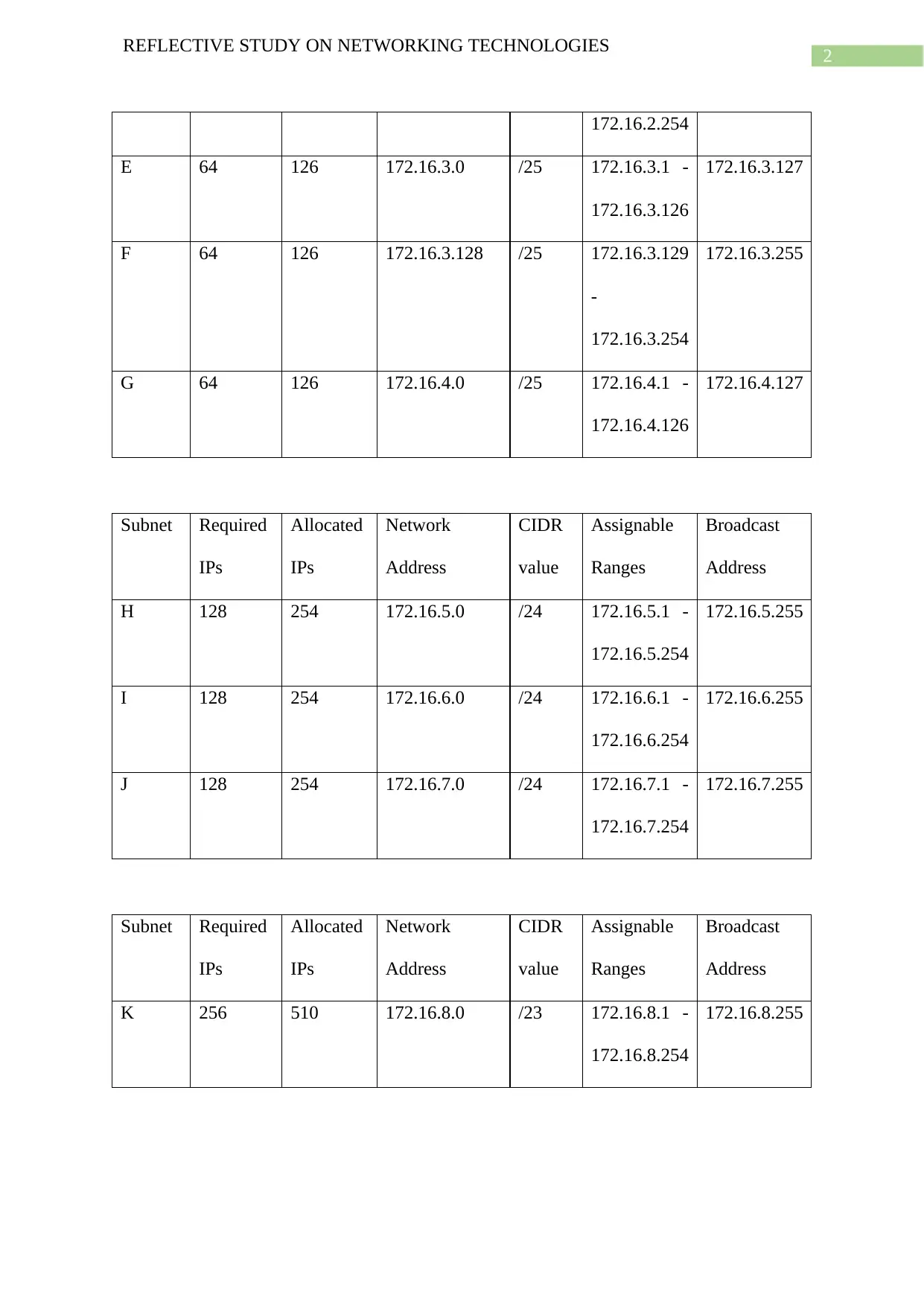
2
REFLECTIVE STUDY ON NETWORKING TECHNOLOGIES
172.16.2.254
E 64 126 172.16.3.0 /25 172.16.3.1 -
172.16.3.126
172.16.3.127
F 64 126 172.16.3.128 /25 172.16.3.129
-
172.16.3.254
172.16.3.255
G 64 126 172.16.4.0 /25 172.16.4.1 -
172.16.4.126
172.16.4.127
Subnet Required
IPs
Allocated
IPs
Network
Address
CIDR
value
Assignable
Ranges
Broadcast
Address
H 128 254 172.16.5.0 /24 172.16.5.1 -
172.16.5.254
172.16.5.255
I 128 254 172.16.6.0 /24 172.16.6.1 -
172.16.6.254
172.16.6.255
J 128 254 172.16.7.0 /24 172.16.7.1 -
172.16.7.254
172.16.7.255
Subnet Required
IPs
Allocated
IPs
Network
Address
CIDR
value
Assignable
Ranges
Broadcast
Address
K 256 510 172.16.8.0 /23 172.16.8.1 -
172.16.8.254
172.16.8.255
REFLECTIVE STUDY ON NETWORKING TECHNOLOGIES
172.16.2.254
E 64 126 172.16.3.0 /25 172.16.3.1 -
172.16.3.126
172.16.3.127
F 64 126 172.16.3.128 /25 172.16.3.129
-
172.16.3.254
172.16.3.255
G 64 126 172.16.4.0 /25 172.16.4.1 -
172.16.4.126
172.16.4.127
Subnet Required
IPs
Allocated
IPs
Network
Address
CIDR
value
Assignable
Ranges
Broadcast
Address
H 128 254 172.16.5.0 /24 172.16.5.1 -
172.16.5.254
172.16.5.255
I 128 254 172.16.6.0 /24 172.16.6.1 -
172.16.6.254
172.16.6.255
J 128 254 172.16.7.0 /24 172.16.7.1 -
172.16.7.254
172.16.7.255
Subnet Required
IPs
Allocated
IPs
Network
Address
CIDR
value
Assignable
Ranges
Broadcast
Address
K 256 510 172.16.8.0 /23 172.16.8.1 -
172.16.8.254
172.16.8.255
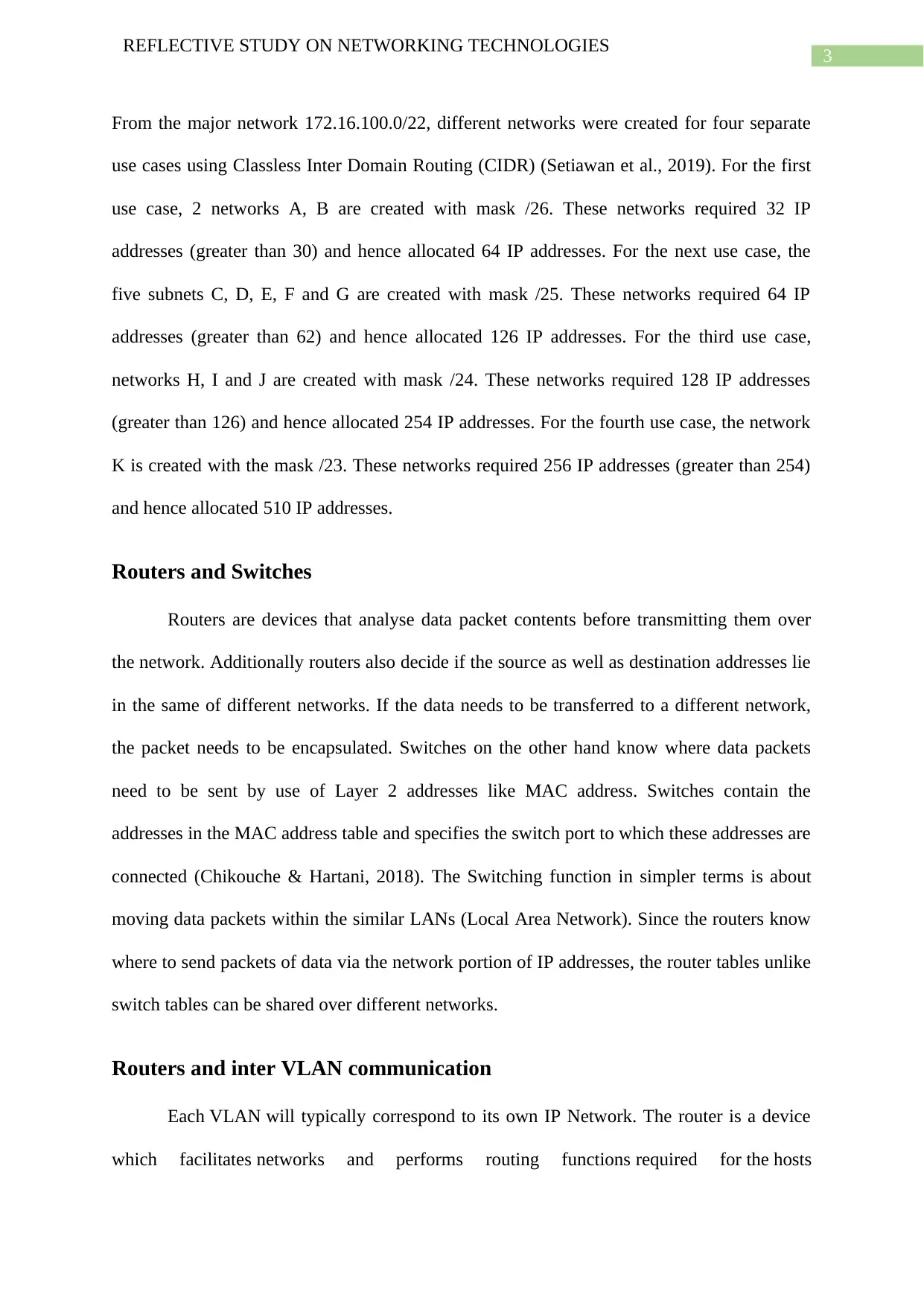
3
REFLECTIVE STUDY ON NETWORKING TECHNOLOGIES
From the major network 172.16.100.0/22, different networks were created for four separate
use cases using Classless Inter Domain Routing (CIDR) (Setiawan et al., 2019). For the first
use case, 2 networks A, B are created with mask /26. These networks required 32 IP
addresses (greater than 30) and hence allocated 64 IP addresses. For the next use case, the
five subnets C, D, E, F and G are created with mask /25. These networks required 64 IP
addresses (greater than 62) and hence allocated 126 IP addresses. For the third use case,
networks H, I and J are created with mask /24. These networks required 128 IP addresses
(greater than 126) and hence allocated 254 IP addresses. For the fourth use case, the network
K is created with the mask /23. These networks required 256 IP addresses (greater than 254)
and hence allocated 510 IP addresses.
Routers and Switches
Routers are devices that analyse data packet contents before transmitting them over
the network. Additionally routers also decide if the source as well as destination addresses lie
in the same of different networks. If the data needs to be transferred to a different network,
the packet needs to be encapsulated. Switches on the other hand know where data packets
need to be sent by use of Layer 2 addresses like MAC address. Switches contain the
addresses in the MAC address table and specifies the switch port to which these addresses are
connected (Chikouche & Hartani, 2018). The Switching function in simpler terms is about
moving data packets within the similar LANs (Local Area Network). Since the routers know
where to send packets of data via the network portion of IP addresses, the router tables unlike
switch tables can be shared over different networks.
Routers and inter VLAN communication
Each VLAN will typically correspond to its own IP Network. The router is a device
which facilitates networks and performs routing functions required for the hosts
REFLECTIVE STUDY ON NETWORKING TECHNOLOGIES
From the major network 172.16.100.0/22, different networks were created for four separate
use cases using Classless Inter Domain Routing (CIDR) (Setiawan et al., 2019). For the first
use case, 2 networks A, B are created with mask /26. These networks required 32 IP
addresses (greater than 30) and hence allocated 64 IP addresses. For the next use case, the
five subnets C, D, E, F and G are created with mask /25. These networks required 64 IP
addresses (greater than 62) and hence allocated 126 IP addresses. For the third use case,
networks H, I and J are created with mask /24. These networks required 128 IP addresses
(greater than 126) and hence allocated 254 IP addresses. For the fourth use case, the network
K is created with the mask /23. These networks required 256 IP addresses (greater than 254)
and hence allocated 510 IP addresses.
Routers and Switches
Routers are devices that analyse data packet contents before transmitting them over
the network. Additionally routers also decide if the source as well as destination addresses lie
in the same of different networks. If the data needs to be transferred to a different network,
the packet needs to be encapsulated. Switches on the other hand know where data packets
need to be sent by use of Layer 2 addresses like MAC address. Switches contain the
addresses in the MAC address table and specifies the switch port to which these addresses are
connected (Chikouche & Hartani, 2018). The Switching function in simpler terms is about
moving data packets within the similar LANs (Local Area Network). Since the routers know
where to send packets of data via the network portion of IP addresses, the router tables unlike
switch tables can be shared over different networks.
Routers and inter VLAN communication
Each VLAN will typically correspond to its own IP Network. The router is a device
which facilitates networks and performs routing functions required for the hosts
Secure Best Marks with AI Grader
Need help grading? Try our AI Grader for instant feedback on your assignments.
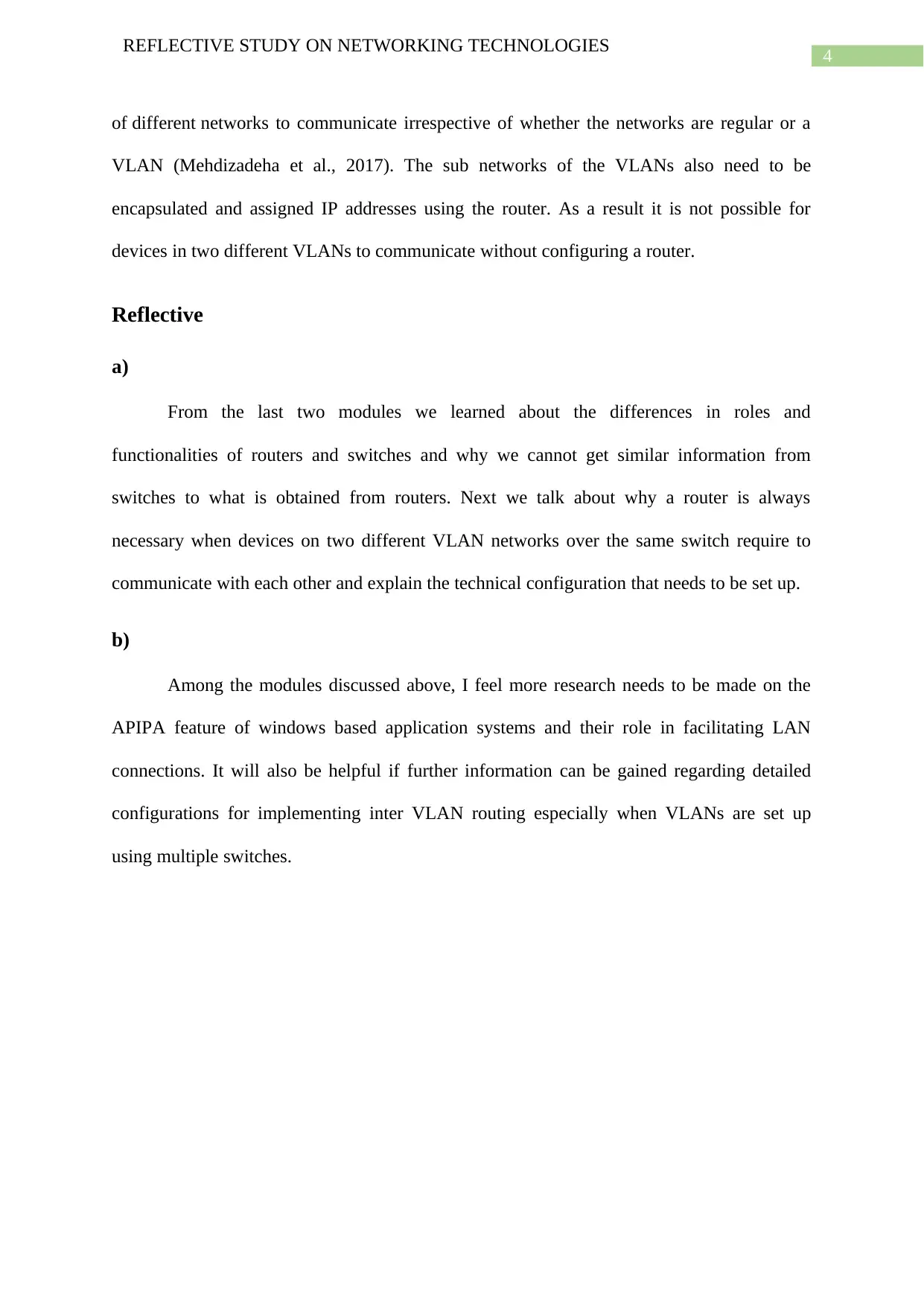
4
REFLECTIVE STUDY ON NETWORKING TECHNOLOGIES
of different networks to communicate irrespective of whether the networks are regular or a
VLAN (Mehdizadeha et al., 2017). The sub networks of the VLANs also need to be
encapsulated and assigned IP addresses using the router. As a result it is not possible for
devices in two different VLANs to communicate without configuring a router.
Reflective
a)
From the last two modules we learned about the differences in roles and
functionalities of routers and switches and why we cannot get similar information from
switches to what is obtained from routers. Next we talk about why a router is always
necessary when devices on two different VLAN networks over the same switch require to
communicate with each other and explain the technical configuration that needs to be set up.
b)
Among the modules discussed above, I feel more research needs to be made on the
APIPA feature of windows based application systems and their role in facilitating LAN
connections. It will also be helpful if further information can be gained regarding detailed
configurations for implementing inter VLAN routing especially when VLANs are set up
using multiple switches.
REFLECTIVE STUDY ON NETWORKING TECHNOLOGIES
of different networks to communicate irrespective of whether the networks are regular or a
VLAN (Mehdizadeha et al., 2017). The sub networks of the VLANs also need to be
encapsulated and assigned IP addresses using the router. As a result it is not possible for
devices in two different VLANs to communicate without configuring a router.
Reflective
a)
From the last two modules we learned about the differences in roles and
functionalities of routers and switches and why we cannot get similar information from
switches to what is obtained from routers. Next we talk about why a router is always
necessary when devices on two different VLAN networks over the same switch require to
communicate with each other and explain the technical configuration that needs to be set up.
b)
Among the modules discussed above, I feel more research needs to be made on the
APIPA feature of windows based application systems and their role in facilitating LAN
connections. It will also be helpful if further information can be gained regarding detailed
configurations for implementing inter VLAN routing especially when VLANs are set up
using multiple switches.
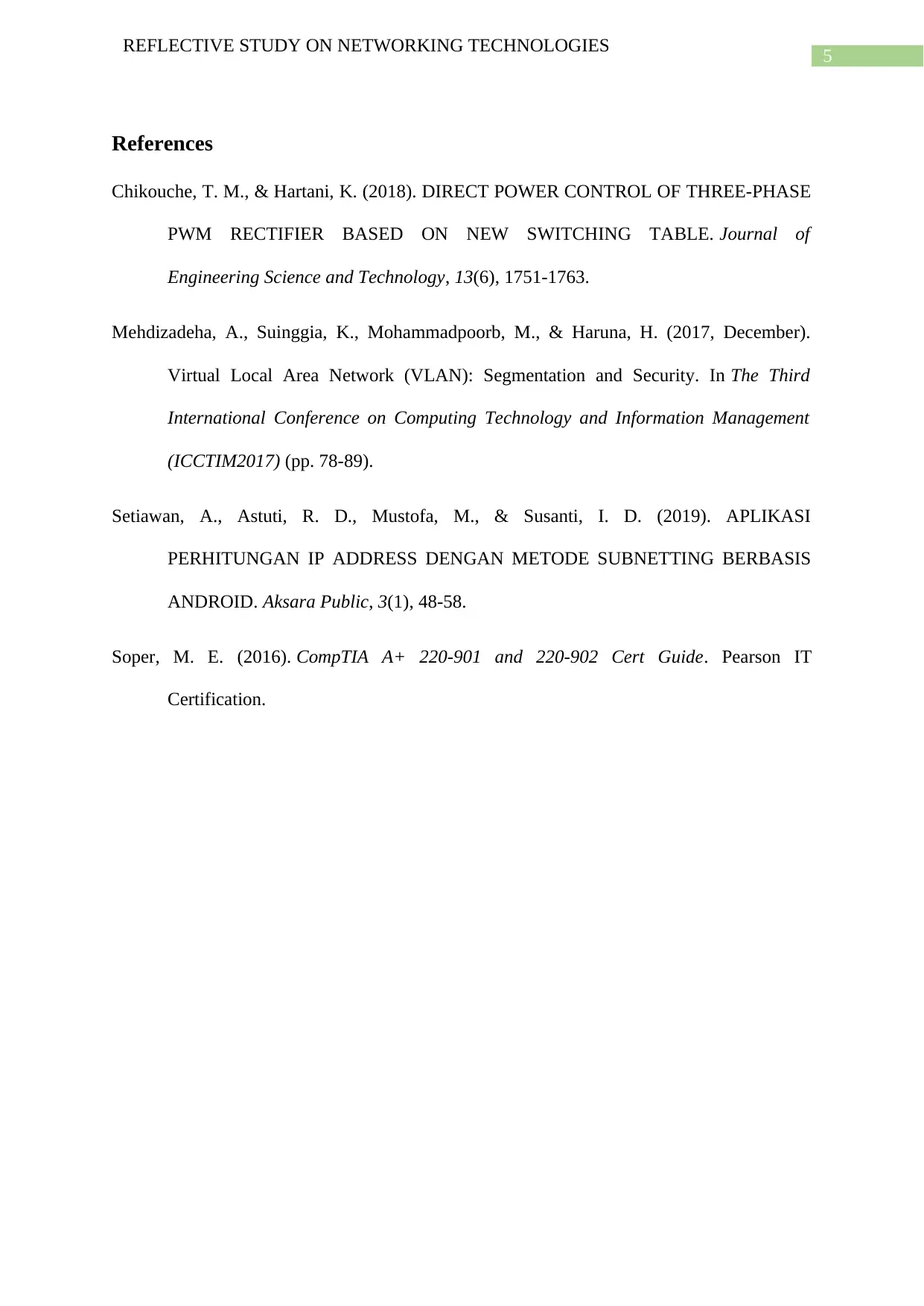
5
REFLECTIVE STUDY ON NETWORKING TECHNOLOGIES
References
Chikouche, T. M., & Hartani, K. (2018). DIRECT POWER CONTROL OF THREE-PHASE
PWM RECTIFIER BASED ON NEW SWITCHING TABLE. Journal of
Engineering Science and Technology, 13(6), 1751-1763.
Mehdizadeha, A., Suinggia, K., Mohammadpoorb, M., & Haruna, H. (2017, December).
Virtual Local Area Network (VLAN): Segmentation and Security. In The Third
International Conference on Computing Technology and Information Management
(ICCTIM2017) (pp. 78-89).
Setiawan, A., Astuti, R. D., Mustofa, M., & Susanti, I. D. (2019). APLIKASI
PERHITUNGAN IP ADDRESS DENGAN METODE SUBNETTING BERBASIS
ANDROID. Aksara Public, 3(1), 48-58.
Soper, M. E. (2016). CompTIA A+ 220-901 and 220-902 Cert Guide. Pearson IT
Certification.
REFLECTIVE STUDY ON NETWORKING TECHNOLOGIES
References
Chikouche, T. M., & Hartani, K. (2018). DIRECT POWER CONTROL OF THREE-PHASE
PWM RECTIFIER BASED ON NEW SWITCHING TABLE. Journal of
Engineering Science and Technology, 13(6), 1751-1763.
Mehdizadeha, A., Suinggia, K., Mohammadpoorb, M., & Haruna, H. (2017, December).
Virtual Local Area Network (VLAN): Segmentation and Security. In The Third
International Conference on Computing Technology and Information Management
(ICCTIM2017) (pp. 78-89).
Setiawan, A., Astuti, R. D., Mustofa, M., & Susanti, I. D. (2019). APLIKASI
PERHITUNGAN IP ADDRESS DENGAN METODE SUBNETTING BERBASIS
ANDROID. Aksara Public, 3(1), 48-58.
Soper, M. E. (2016). CompTIA A+ 220-901 and 220-902 Cert Guide. Pearson IT
Certification.
1 out of 6
Related Documents
Your All-in-One AI-Powered Toolkit for Academic Success.
+13062052269
info@desklib.com
Available 24*7 on WhatsApp / Email
![[object Object]](/_next/static/media/star-bottom.7253800d.svg)
Unlock your academic potential
© 2024 | Zucol Services PVT LTD | All rights reserved.





